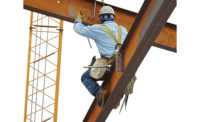Hydraulic fracturing or “fracking” is a process used to “stimulate” well production in the oil and gas industry. It is not a new process, but its use has increased significantly in the last 10 years because of new horizontal drilling and multi-stage technologies that improve access to natural gas and oil deposits. It involves pumping large volumes of water and sand into a well at high pressure to fracture shale and other tight formations, allowing oil and gas to flow into the well.
Workplace hazards are present in most industries, and oil and gas drilling is no different. According to the Bureau of Labor Statistics, the fatality rate for the oil and gas industry was 28.8 per 100,000 workers, more than seven times higher than the rate for all industries. Two hazards in the oil and gas industry cause over 50 percent of the injuries: struck-by hazards at 36 percent and caught-in or between hazards at 21 percent. These types of injuries can occur throughout the site preparation, drilling, well completion and servicing stages of well operation.
Struck-by
According to OSHA, the term “struck-by” is defined as injuries produced by forcible contact or impact between the injured person and an object or piece of equipment. The impact of the object is the cause of the injury.
Proper equipment installation and maintenance on an oil rig is often more important than in other industries. Due to the unique processes used in drilling, vibration and material fatigue are heightened, which can result in catastrophic failure. There are times when improperly installed equipment falls off the rig or the equipment comes apart, is thrown and strikes an employee.
OSHA breaks down struck-by hazards into the following categories:
- Struck-by a flying object
- Struck-by a falling object
- Struck-by a swinging object
- Struck-by a rolling object
These apply to the oil and gas industry in the following ways:
Struck-by a flying object
The catastrophic failure of equipment on the oil rig can often result in the equipment breaking apart and being propelled with considerable force at an employee.
Examples of this hazard would be a high pressure hose connection that fails causing the whipping hose to strike an employee, a length of chain fails and hits the employee, wire rope breaks and strikes a worker, a pipe that is over-pressurized breaks apart and pieces of it hit a worker. Broken bones, punctures and lacerations can result.
Protect employees from these types of injuries by inspecting equipment connections, checking pressure gauges, using proper lubrication, and replacing defective chain and wire rope. Use appropriate personal protective equipment (PPE) like eye and face protection.
Struck-by a falling object
Objects falling off the rig’s superstructure, the tops of tanks, building roofs, scaffolding, aerial lifts, cranes and forklifts can strike employees working nearby. These items could be pipe, tools, bolts, lumber or anything lying around loose. Gravity causes the object to travel with speed and force. Broken bones and puncture injuries can occur when workers are struck.
Protect employees from being injured by falling objects by using appropriate toe boards, identifying and barricading the areas below work zones, and requiring PPE such as hard hats to be used.
Struck-by a swinging object
When tripping pipe in and out, the derrickman or the floor hands can be struck by the suspended pipe. Workers can also be struck by traveling block as it moves up and down.
Another common piece of equipment found on oil and gas sites is the crane. Excavators are also used to dig the shale pit and level off the site. Crushing injuries are often the result of being struck by the revolving superstructure of a crane or an excavator.
Train new employees in the operation of the drill rig and where to safely stand when pipe is being tripped in or out. Protect employees by barricading the swing radius of cranes and excavators. Display signage on cranes that identifies swing hazard areas.
Struck-by a rolling object
Semi-tractor trailers, crew trucks, service vehicles, end loaders, excavators and forklifts can pose struck-by hazards. Severe crushing injures can occur due to the weight and force of being hit by this equipment.
Protect employees on the ground by instructing equipment operators to be aware of employees working around the equipment. Workers on the ground should stay alert and be aware of equipment moving nearby.
Caught-in or between
According to OSHA, the term “caught-in or between” is defined as injuries resulting from a person being squeezed, caught, crushed, pinched or compressed between parts of an object. In the oil and gas industry, this is usually being caught in machinery or equipment, or being compressed or crushed between rolling, sliding or shifting objects.
Caught in machinery or equipment
Being pulled into or caught in machinery or equipment can cause amputations, broken bones, internal injuries and strangulation. Floor hands can be caught in spinning chain or parts of the rotating system (the kelly or the rotary table) and in the draw-works.
To prevent this type of accident, do not remove machine guards unless lockout/tagout procedures have been implemented. Do not wear loose clothing when working around revolving spindles, drums or drive shafts. Train new employees on the hazards of working on the drill rig.
Being compressed or crushed between rolling, sliding or shifting objects
Some examples of how this hazard occurs are when an employee is:
- Caught between a vehicle and another object,
- Pinched between equipment and the rig’s substructure, and
- Crushed between a load of pipe that fell off a trailer and forklift.
Instruct workers to be alert and aware of their surroundings at all times and to understand the hazards associated with the task they are performing.
Wrap-up
Employees working in the oil and gas well drilling industry face numerous dangers with struck-by and caught-in or between hazards being at the top of the list. In addition, there are many new oilfield workers starting each and every day. Training these new employees is the key to preventing injuries and fatalities. All employees should understand the hazards associated with their work and how to mitigate these hazards.


